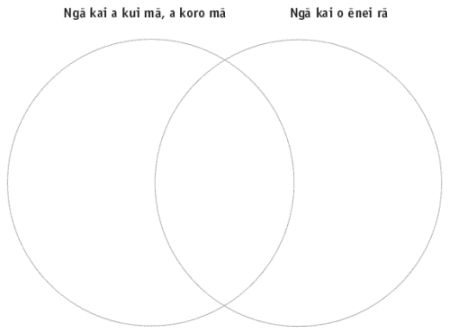Kōtukutuku
nā Rona Lawson
In this narrative tamariki beg their whaea for money to buy lollies. She tries to persuade them to eat the sweet, healthy fruits available in the environment.
Ngā hononga ki te marautanga
Te Reo Māori i roto i te Marautanga o Aotearoa (wh.59, 67, 76, 85, 94, me 102)
| Whenu | Whakarongo (Kōrero) |
| Kōeke | 2 |
| Whāinga paetae | Ka taea e te ākonga te āta whakarongo, te whakautu ngā kōrero e kōrero whānuitia ana ahakoa kei hea, kei hea. |
| Pūkenga | Ko te whakarite whakautu e hāngai ana ki te kaupapa o te pātai. |
| Whenu | Kōrero (Whakarongo) |
| Kōeke | 2 |
| Whāinga paetae | Ka taea e te ākonga te whakapuaki whakaaro ki ōna hoa, ki ngā pakeke e mōhiotia ana, ngā horopaki e taunga ana ia. |
| Pūkenga | Ko te whiu me te whakautu pātai āhua uaua. |
| Whenu | Pānui (Tuhituhi) |
| Kōeke | 2 |
| Whāinga paetae | Ka mārama te ākonga ki te huhua noa o ngā tuhinga poto kua tīpakona hei whakangahau, hei whakamōhio rānei i a ia. |
| Pūkenga | Ko te rapu mōhio motuhake mai i ngā tuhinga poto. |
| Whenu | Tuhituhi (Pānui) |
| Kōeke | 2 |
| Whāinga paetae | Ka taea e te ākonga te tuhituhi mō tētahi wā ia rā hei whanake i te reo kua mau i a ia, hei kawe hoki i ōna wheako. |
| Pūkenga | Ko te tuhi i ngā tuhinga whakaahua poto e pā ana ki ōna wheako whaiaro. |
| Whenu | Mātakitaki (Whakaatu) |
| Kōeke | 2 |
| Whāinga paetae | Ka mārama te ākonga ki te hononga o te reo ataata ki te reo ā‑waha, mehemea ka puta ake i ngā horopaki e taunga ana ia. |
| Pūkenga | Ko te tāutu i ngā mōhiotanga e tika ana kia mau i te ākonga mai i ngā reo ataata e whakaaturia ana ki te taha o te reo ā‑waha. |
| Whenu | Whakaatu (Mātakitaki) |
| Kōeke | 2 |
| Whāinga paetae | Ka taea e te ākonga te whakaputa reo ā‑waha, reo ataata hoki e pā ana ki ngā kaupapa e taunga ana ia. |
| Pūkenga | Ko te hanga i ngā ataata whakaniko te reo ā‑waha. |
Hei mahi
- Use the guided reading approach with an instructional reading group. Share the title and author’s name with the group. Say: “Today we are learning about the author’s message.” “I tēnei rā kei te ako tātou i te tino kaupapa a te kaituhi.”
- Set the following questions prior to having the students read these pages of text:
- page 19: 'Kimihia te kīwaha e whakahē ana i te tono a ngā tamariki.'
- page 20: 'Ka kōrero te whāea. Ki ō koutou whakaaro he aha i pērā ai te kōrero a te whāea?'
- page 21 – 'He aha ngā mahi a te whāea i te ngahere i a ia e tamariki ana?'
- page 22 – 'I pēhea nei te kohikohi a Whāea mā i ngā hua o te Kōtukutuku?'
- page 23 – 'He aha te rerenga e whakaatu ana i ngā whakaaro o te whāea mō ngā kai o ēnei rā.'
- page 24 – 'Kei te pēhea ngā whakaaro o te whāea i nāianei? Ko ēhea ngā kupu e tautoko ana i ō koutou whakaaro?'
Finish this session by discussing the author’s message. Students should back up their opinions by referring to parts of the text that support their thoughts. -
Tell the students: 'Today we are comparing foods eaten by our tūpuna with the types of food we eat now.'
Students work in pairs to gather information and present their work as a Venn diagram. The students may need assistance to understand the intersecting area of the diagram. - Pairs of students visit other classes, display their diagrams, and explain what they have learnt about the foods eaten by their tūpuna.
- Students create a restaurant menu consisting of foods eaten by their tūpuna that are not eaten today.
Aromatawai
The students identify the author’s message.
The students display information on a Venn diagram.




